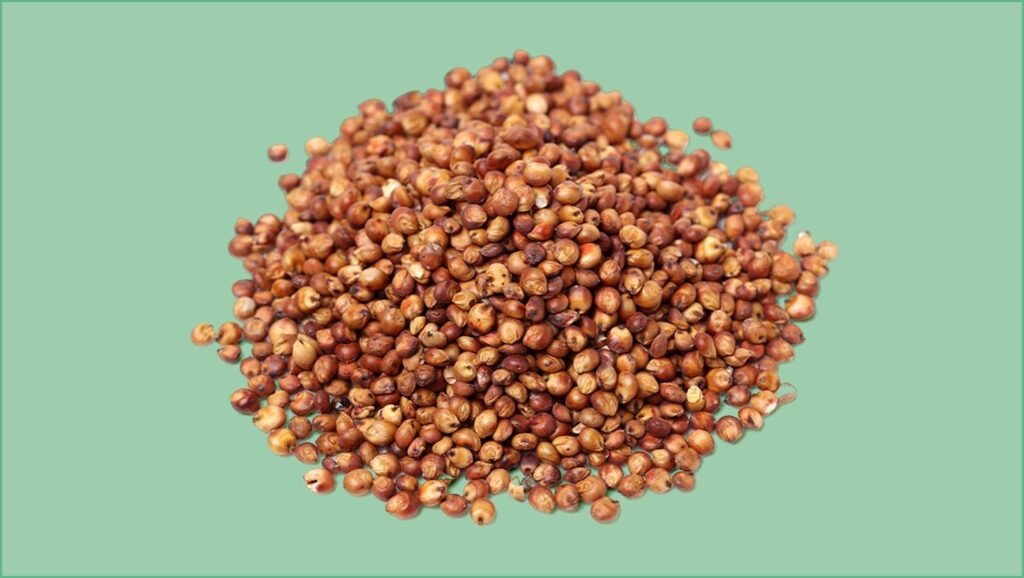Sorghum, often called “guinea corn”, started in Africa and now feeds people around the world. It stands out because it tolerates dry soils and punishing heat better than many other grains. That resilience makes it a smart crop for places where water is scarce.
People use sorghum in lots of ways, and much of it gets ground into flour for staples like bread, porridge and pancakes. The grain’s texture and mild flavor make it easy to adapt across cuisines. It can be a gluten-free base or a hearty addition to mixed-grain recipes.
On top of being adaptable, sorghum brings real nutrition to the table. It’s not a fad; it’s a practical, nourishing ingredient that packs steady calories and useful micronutrients. If you want a grain that does more than just fill you up, sorghum deserves a look.
Nutrition Snapshot
A 1/4 cup of dry sorghum provides about 158 calories, which puts it in the same ballpark as oats and barley by calorie density. Those calories are mostly carbohydrate, making sorghum an efficient energy source for active days. It’s not calorie-heavy compared to many refined grains, and it delivers more than empty energy.
That 1/4 cup also supplies roughly 5 grams of protein, helping meet daily needs for both men and women in a modest way. Protein in sorghum helps with cell maintenance and repair, especially when combined with other protein sources. While it’s not a complete protein on its own, it pairs well with legumes or dairy for balance.
Carbohydrates dominate the profile, with about 35 grams per 1/4 cup and around 3 grams of fiber. That fiber is indigestible bulk, which helps move food through the gut and supports regularity. Fiber in sorghum also plays a role in lowering blood cholesterol and improving overall heart health.
Sorghum is a low-fat grain, containing under 2 grams of total fat per serving and only a fraction of that in saturated fat. Choosing grains like sorghum can help keep overall dietary fat in check when part of a balanced meal plan. Lower fat intake from grains can support weight management and reduce heart disease risk.
Minerals are a highlight for sorghum, not just calories and carbs. A 1/4 cup delivers calcium, iron, phosphorus and potassium in useful amounts for everyday needs. Those minerals support bone strength, oxygen transport and fluid balance, all critical for basic body functions.
Specifically, sorghum supplies a modest amount of calcium and notable phosphorus for bone health. Iron in sorghum helps carry oxygen through the bloodstream and supports growth and repair. Potassium in the grain helps manage fluid balance and can contribute to healthy blood pressure when included in a potassium-rich diet.
One serving of sorghum is naturally low in sodium, which is a plus for anyone watching blood pressure. With only about 1 milligram of sodium per 1/4 cup, sorghum helps you avoid hidden salt loads found in processed foods. That makes it a strong option when you’re building meals mindful of heart health.
Compared to more common grains, sorghum stacks up well on nutrition while offering farming advantages. Its drought tolerance means fewer irrigation demands, which can lower costs and environmental pressure. That hardiness also makes sorghum an important crop for food security in dry regions.
For people seeking diversity in whole grains, sorghum adds texture and variety to the pantry. It can be cooked whole like rice, popped like popcorn, or milled into flour for baking. Those different forms make it a flexible ingredient for both home cooks and commercial food makers.
Because sorghum is gluten-free, it’s a useful option for people with celiac disease or gluten sensitivity. Swapping sorghum flour for wheat in baked goods often requires recipe tweaks, but it delivers earthy flavor and structure. For gluten-free diets, sorghum helps expand options beyond rice and corn.
Using sorghum in everyday meals is straightforward and satisfying. Try it in porridge for breakfast, toss cooked grain into salads for texture, or replace part of the wheat flour in pancakes for a nuttier bite. Small switches like this boost nutrient variety without complicating routines.
At a population level, sorghum supports resilient agriculture and offers nutritional returns on farming investment. It’s a smart choice where water is limited and yields need to be reliable. That combination of hardiness and nutrition is rare among staple crops.
For shoppers, look for whole-grain sorghum in health food aisles or as flour in baking sections. Store the grain in a cool, dry place and the flour in the fridge if you won’t use it quickly. Proper storage preserves flavor and keeps oils from turning rancid.
Cooking whole sorghum is similar to cooking other whole grains and takes about 50 minutes to an hour for tender kernels. Rinse the grain, simmer in water until soft, then season or mix it into dishes as you would rice or farro. For quicker meals, consider pre-soaked sorghum or pressure cooking to cut the time down.
Sorghum’s combination of practical farming traits and solid nutrition makes it more than a backup grain. It’s a go-to option when you want something that performs in the field and on the plate. Versatile, resilient and nutritious, sorghum earns a place in sustainable kitchens and diets.
